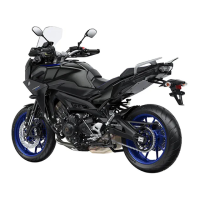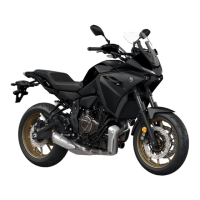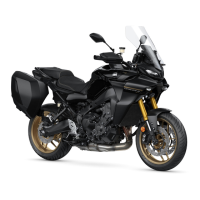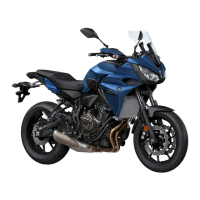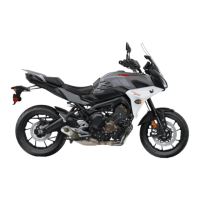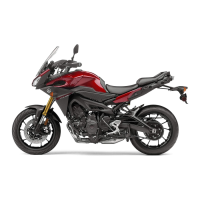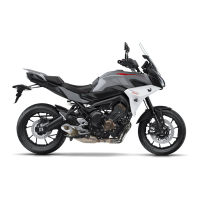Do you have a question about the Yamaha Tracer 9 and is the answer not in the manual?
Owner's responsibilities for safe motorcycle operation and maintenance.
Tips for safe operation, visibility, and accident avoidance.
Essential gear for rider protection during operation.
Hazards of carbon monoxide and precautions for safe use.
Guidelines for adding cargo or accessories to maintain stability.
Instructions for securing the motorcycle for transport in another vehicle.
Identification of components visible from the left side of the motorcycle.
Identification of components visible from the right side of the motorcycle.
Location and identification of handlebars, switches, and instrument panel.
How to activate, set, and adjust the cruise control system.
Adjusting engine response and output modes for different riding conditions.
Adjusting suspension damping force for riding comfort and performance.
Managing traction, slide, and lift control systems for enhanced safety.
Clutch-less electronic gear shifting system for upshifts and downshifts.
ABS and cornering brake control system settings and operation.
System for theft prevention and key registration procedures.
Operation of the ignition, lighting, and steering lock.
Functions of various switches on the left and right handlebars.
Meaning and function of dashboard lights and warning indicators.
Understanding the main and sub-display screens and their information.
Accessing and changing vehicle settings via the menu system.
Checking fuel level, lines, and overflow hose for proper function.
Verifying engine oil and coolant levels and for leaks.
Ensuring brake operation, fluid levels, pads, and hydraulic system integrity.
Inspecting tires for damage, tread depth, and air pressure.
Checking drive chain slack and lubricating control cables.
Guidelines for the initial engine running period to ensure longevity.
Step-by-step instructions for starting the motorcycle's engine safely.
Proper techniques for shifting gears and slowing down the vehicle.
Advice on riding style and practices to improve fuel efficiency.
Safe methods for parking the motorcycle, considering heat and slopes.
General guidelines for inspection, adjustment, and lubrication intervals.
Procedures for checking, cleaning, and replacing spark plugs.
Steps for checking, changing engine oil, and replacing the oil filter.
Checking coolant level and procedures for changing coolant.
Inspecting tires, checking pressure, and replacement guidelines.
Adjusting lever play, checking pads, fluid levels, and changing fluid.
Checking and adjusting drive chain slack, cleaning, and lubricating.
How to identify and replace blown fuses in the electrical system.
Recommended methods and precautions for washing and cleaning the motorcycle.
Guidelines for storing the motorcycle properly to prevent damage.
Location and importance of VIN, engine serial, and model label.
Information on how vehicle data is stored, used, and protected.
Owner's responsibilities for safe motorcycle operation and maintenance.
Tips for safe operation, visibility, and accident avoidance.
Essential gear for rider protection during operation.
Hazards of carbon monoxide and precautions for safe use.
Guidelines for adding cargo or accessories to maintain stability.
Instructions for securing the motorcycle for transport in another vehicle.
Identification of components visible from the left side of the motorcycle.
Identification of components visible from the right side of the motorcycle.
Location and identification of handlebars, switches, and instrument panel.
How to activate, set, and adjust the cruise control system.
Adjusting engine response and output modes for different riding conditions.
Adjusting suspension damping force for riding comfort and performance.
Managing traction, slide, and lift control systems for enhanced safety.
Clutch-less electronic gear shifting system for upshifts and downshifts.
ABS and cornering brake control system settings and operation.
System for theft prevention and key registration procedures.
Operation of the ignition, lighting, and steering lock.
Functions of various switches on the left and right handlebars.
Meaning and function of dashboard lights and warning indicators.
Understanding the main and sub-display screens and their information.
Accessing and changing vehicle settings via the menu system.
Checking fuel level, lines, and overflow hose for proper function.
Verifying engine oil and coolant levels and for leaks.
Ensuring brake operation, fluid levels, pads, and hydraulic system integrity.
Inspecting tires for damage, tread depth, and air pressure.
Checking drive chain slack and lubricating control cables.
Guidelines for the initial engine running period to ensure longevity.
Step-by-step instructions for starting the motorcycle's engine safely.
Proper techniques for shifting gears and slowing down the vehicle.
Advice on riding style and practices to improve fuel efficiency.
Safe methods for parking the motorcycle, considering heat and slopes.
General guidelines for inspection, adjustment, and lubrication intervals.
Procedures for checking, cleaning, and replacing spark plugs.
Steps for checking, changing engine oil, and replacing the oil filter.
Checking coolant level and procedures for changing coolant.
Inspecting tires, checking pressure, and replacement guidelines.
Adjusting lever play, checking pads, fluid levels, and changing fluid.
Checking and adjusting drive chain slack, cleaning, and lubricating.
How to identify and replace blown fuses in the electrical system.
Recommended methods and precautions for washing and cleaning the motorcycle.
Guidelines for storing the motorcycle properly to prevent damage.
Location and importance of VIN, engine serial, and model label.
Information on how vehicle data is stored, used, and protected.
| Displacement | 890cc |
|---|---|
| Bore x Stroke | 78.0 mm x 62.1 mm |
| Compression Ratio | 11.5:1 |
| Fuel System | Fuel Injection |
| Transmission | 6-speed |
| Frame Type | Diamond |
| Front Suspension | Telescopic Fork |
| Front Suspension Travel | 130 mm |
| Rear Suspension Travel | 137 mm |
| Front Brake | Hydraulic dual disc, Ø 298 mm |
| Rear Brake | Hydraulic single disc, Ø 245 mm |
| Front Tyre | 120/70ZR17M/C (58W) |
| Rear Tyre | 180/55ZR17M/C (73W) |
| Overall Length | 2, 175 mm |
| Overall Width | 885 mm |
| Overall Height | 1, 430 mm - 1, 470 mm |
| Seat Height | 810 mm / 825 mm |
| Wheelbase | 1, 500 mm |
| Ground Clearance | 135 mm |
| Lubrication System | Wet sump |
| Clutch Type | Wet, Multiple Disc |
| Ignition System | TCI |
| Starter System | Electric |
| Final Transmission | Chain |
| Fuel Consumption | 5.0 L/100 km |
| Oil Tank Capacity | 3.5 L |
| Engine Type | Liquid-cooled, 4-stroke, DOHC, 3-cylinder |
| Maximum Power | 119 PS (87.5 kW) @ 10, 000 rpm |
| Maximum Torque | 93.0 Nm (9.5 kg-m) @ 7, 000 rpm |
| Rear Suspension | Swingarm |
